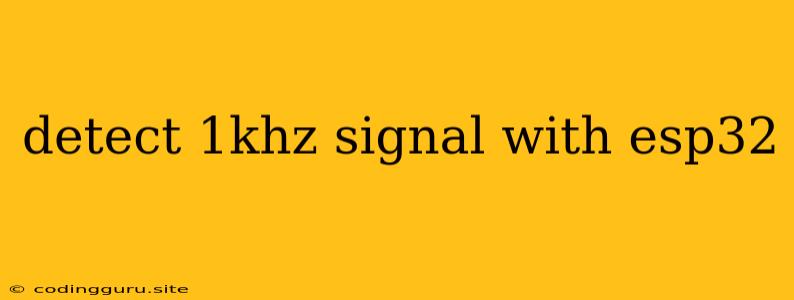Detecting a 1kHz Signal with the ESP32
The ESP32 is a powerful microcontroller with built-in analog-to-digital converters (ADCs) that can be used to detect and analyze analog signals. One common task is detecting a 1kHz signal, which can be useful for various applications like audio processing, remote control, and sensor data acquisition. This article will guide you through the process of detecting a 1kHz signal using the ESP32.
Understanding the Basics
Before diving into the code, it's essential to understand the fundamental principles involved.
- Analog-to-Digital Conversion: The ESP32's ADC converts an analog voltage to a digital value. This allows us to read and process analog signals in our code.
- Signal Frequency: The frequency of a signal refers to the number of cycles it completes per second. A 1kHz signal completes 1000 cycles per second.
- Sampling Rate: The ADC samples the analog signal at a specific rate, known as the sampling rate. To accurately detect a 1kHz signal, the sampling rate should be at least twice the signal frequency (Nyquist-Shannon sampling theorem). This means a sampling rate of 2kHz or higher is recommended.
Setting Up the ESP32
- Connect the Signal: Connect the analog signal to an ESP32 ADC pin.
- Configure the ADC: Use the Arduino IDE or a suitable development environment to set up the ESP32 ADC.
- Specify the ADC pin to use.
- Set the ADC resolution (e.g., 12 bits).
- Adjust the sampling rate to a value greater than 2kHz.
Detecting the 1kHz Signal
Now, let's discuss the code structure and the algorithms for detecting the 1kHz signal:
-
Sampling the Signal: Continuously read analog values from the ADC pin using the
analogRead()function (or its equivalent in your chosen library). -
Signal Processing: Analyze the sampled data to identify the presence of the 1kHz signal. Here are a few commonly used methods:
- Peak Detection: Look for peaks in the sampled data that correspond to the signal's positive and negative cycles.
- Zero-Crossing Detection: Identify the points where the signal crosses the zero voltage level.
- Fourier Transform: Analyze the frequency components of the sampled data using a Fast Fourier Transform (FFT) algorithm. This method can precisely detect the 1kHz frequency and distinguish it from other frequencies present in the signal.
-
Decision Making: Based on the results of the signal processing algorithms, determine if the 1kHz signal is present. You can use thresholds or other criteria to make this decision.
Code Example (Simplified)
#include
const int analogPin = 34; // ADC pin
const int samplingRate = 4000; // Sampling rate in Hz
void setup() {
Serial.begin(115200);
analogReadResolution(12); // Set ADC resolution
analogSetSamplingSpeed(samplingRate); // Set sampling rate
}
void loop() {
int signalValue = analogRead(analogPin);
// Implement signal processing logic here (e.g., peak detection, zero-crossing)
// Example: Basic peak detection
if (signalValue > 512) { // Assuming a 12-bit ADC
Serial.println("1kHz signal detected!");
}
delay(10); // Adjust delay to match sampling rate
}
Note: This is a simplified example and the actual implementation may vary depending on the specific signal processing method used.
Tips for Successful Detection
- Signal Amplitude: Ensure the signal amplitude is within the ADC's measurement range. You may need to amplify the signal using a preamplifier if the signal is too weak.
- Noise Filtering: Implement noise filtering techniques (e.g., averaging, moving average filters) to reduce noise interference and improve detection accuracy.
- Calibration: Calibrate the ADC by measuring a known voltage level and adjusting the code accordingly.
- Real-Time Analysis: For real-time applications, consider using a timer interrupt to trigger the signal sampling and processing at regular intervals.
Conclusion
Detecting a 1kHz signal with the ESP32 can be achieved by utilizing the ADC, sampling the analog signal, and applying appropriate signal processing techniques. Remember to consider the signal characteristics, noise reduction, and calibration for optimal results. The ESP32's capabilities and flexible programming environment make it an ideal choice for various applications involving signal detection and analysis.
